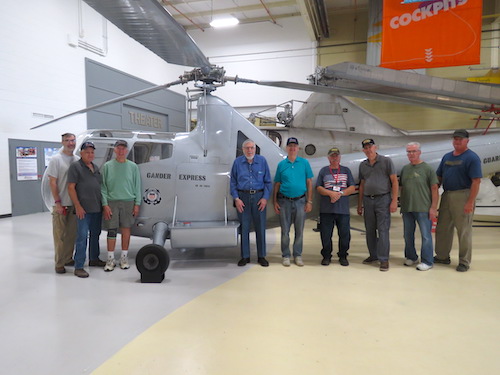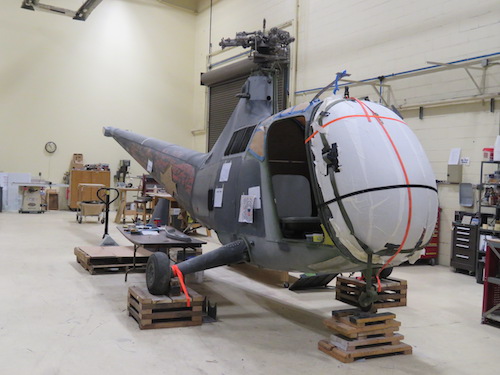|
Jan
17
2022
|
|
Posted 3 years 359 days ago ago by Admin
|
|

The American Helicopter Museum & Education Center (AHMEC) in West Chester, Pennsylvania, recently unveiled the crown jewel of its collection: the United States Coast Guard (USCG) HOS-1 that played a leading role in one of the most famous rescues in helicopter history. Also known as a Sikorsky R-6, AHMEC’s HOS-1 (#43-45531) and her crew received accolades for saving survivors of a downed Sabena Airlines DC-4 airliner near Gander, Newfoundland, in 1946, earning her the nickname, “The Gander Express.”
The DC-4 departed Shannon, Ireland, with 37 passengers and seven crew, but crashed due to bad weather in a densely wooded area of Newfoundland. The USCG responded by sending two helicopters via military cargo aircraft. Both the HNS-1 (Sikorsky R-4) from Elizabeth City, North Carolina, and HOS-1 from Brooklyn, New York, were dismantled for the journey and reassembled at the site. They successfully completed 40 flights to fly as many people as possible to safety.
The R-6 evolved, with some noticeable changes, from the fabric-covered R-4 in 1945,. While it retained the rotor and transmission system of its predecessor, it had a more powerful engine (236 hp Franklin 0-405-9) and all-metal tail boom, and its streamlined fuselage sported phenolic resin panels.
Sikorsky built the first experimental models in 1943, then the Nash Kelvinator Corporation produced 193, from which the Navy acquired 36, designating them HOS-1s, and sold 27 to the USCG between 1945 and ‘46. The “Gander Express” was one of them.
In 1975 the New England Air Museum (NEAM) received two R-6s (#43-45531 and #43-45480), complete with documentation, including logbooks, as a gift from Frank Pacheco of Esmond, Rhode Island. Peter Wright of Bryn Mawr, Pennsylvania, restored #43-45480, the Doman R-6, on display at NEAM, and received #45-45531 in parts (cockpit, tail boom, main and tail rotors) as payment on 1 June 2001, which he placed in storage. Wright, one of AHMEC’s founders, bequeathed “The Gander Express” to the museum in 2008 as part of his vintage aircraft collection.
Since AHMEC’s mission is to preserve, educate, and inspire, the Restoration Committees decided that the historic aircraft needed her glory reclaimed. They assessed the missing parts, severe condition of existing panels, lack of a windscreen, and minimal design drawings.

Once they evaluated aircraft, the committees enlisted their all-volunteer crew for the challenging project. They began painstaking tasks that included making the tooling for fabricating fiberglass molds and panels, replacing the tail boom skin, replacing the cockpit flooring, forming a tail rotor casting, and repairing tears to the fabric-covered rotor blades.
One of the most arduous jobs was forming the windscreen. The museum had received a full-size male plaster mold that was in disrepair. The overall dimensions and shape of the mold suggested it looked close enough to repair, fabricate a fiberglass skin over the mold, then using that fiberglass skin to verify that it would fit the aircraft. The fit was determined to be satisfactory, and the skin was then used to fabricate a fiberglass mold for forming the acrylic windscreen.
The museum contacted a plastics company that specialized in molding acrylic aircraft bubbles. Some adjustments to the fiberglass mold were necessary before shipping it to them for molding. When finished, the windscreen was returned, then trimmed to size.
The next step was the installation. Although the trial fitting of the fiberglass skin proved successful, the plaster model was not built to a factory blueprint, therefore, the fit wasn’t close enough to install it using the factory method. Instead, the crew successfully bonded it in place with a high strength silicone aerospace adhesive.
“We’re fortunate to have restored the first Sikorsky HOS-1 that was involved in the first Coast Guard large-scale air rescue,” stated Douglass Schaeffer, AHMEC’s head of restoration. “This is the first complete restoration from start to finish that was done entirely in-house, for a total of 4,000 hours. It is also the only HOS-1 on display anywhere.”
Visit the American Helicopter Museum & Education Center’s website at www.americanhelicopter.museum.
READ MORE ROTORCRAFT PRO NOV/DEC ISSUE